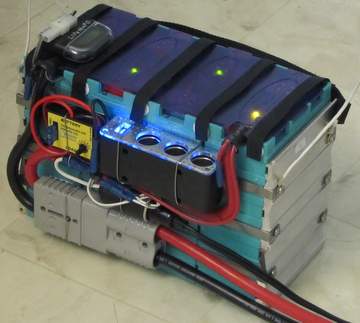 |
Block diagram of components with voltages & specifications |
 |
Engine: 150 A ANL fuse; solenoid; solenoid activation wire; 2 AWG to LiFeMnPO in back of van |
 |
Curve for discharge and charge Voltages for a LiFeMnPO cell |
 |
Meter power & signal; 100mv/100A shunt; 2 AWG chassis ground cable; 150A ANL fuse |
 |
Discharge curve for lead-acid chemistry batteries (FLA, AGM Gel Cel) |
 |
LiFeMnPO installed in the back as the house battery |
 |
Power & energy density of various capacitors, fuel cells & various battery chemistries |
 |
LiFeMnPO meters' hook-up diagram |

|
 |
Red-hot wire carrying 15 Amps with a test LiFeMnPO battery |
 |
Ignition key off: separates LiFeMnPO from the van's electrical system. Current is actually zero, not .4 A |
 |
Fuse block; solenoid; 2 AWG cable; fuse block; LiFeMnPO; 10 AWG hook-up wire; Anderson contact; LVD; load sockets; refrigerator socket; 110 V AC inverter; refrigerator cord |
 |
Key turned, engine off: -11.1 Amps LiFeMnPO current charging van battery and powering accessories |
 |
Soldered small wires to a few strands of the large cable before crimping with conductive paste; Anderson connecter @ top |
 |
Engine running: 31.4 Amp current shows LiFeMnPO being charged by the van alternator |
 |
Low-Voltage Disconnect is a must for saving any deep cycle battery from under-voltage severe damage (we use 11.5 V) |
 |
Overhead LED floodlights shine light on the meters for night driving |